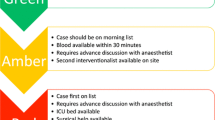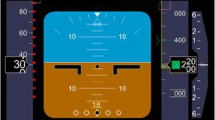Dr. Jones, an anesthesiologist, boards a plane to visit her ailing father who is scheduled to have a colectomy after recently being diagnosed with colon cancer. She is worried about his cardiac status and long-standing history of diabetes. Having been in practice for 20 years, she is also concerned about a number of aspects of his care. Will he receive his usual dose of insulin despite the fact that he is NPO? Will he receive prophylactic antibiotics within an appropriate time frame? Will his ß-blockers be continued? Will the anesthesia team monitor his glucose during his procedure? Will he become hypothermic? Will he suffer any cognitive dysfunction as a result of his anesthetic?
Glancing through the door at the cockpit as she boards the plane, Dr. Jones considers the often-cited similarity of the work environments of pilots and anesthesiologists. She imagines that the pilot would be as bewildered by the array of physiologic/ventilatory monitors as she is by the myriad of aircraft monitors. However, as she takes her seat, she realizes that a profound difference exists between their work environments. Dr. Jones is not concerned about the pilot or the air traffic controller (both of whom she has never met). She is not concerned about this particular aircraft (on which she has never flown). The length of her flight is not dependent on which particular pilot is in charge of the aircraft or which individual air traffic controller is involved in transferring the aircraft from one geographic zone to another. She does not worry about whether the plane has enough fuel to get to her destination, whether the plane will land on the runway (and not before or after), whether the plane will come too close to another plane, or whether the takeoff speed will be sufficient to get the plane airborne.
Access this chapter
Tax calculation will be finalised at checkout
Purchases are for personal use only
Preview
Unable to display preview. Download preview PDF.
Similar content being viewed by others
References
Dosing errors kills 2 preemies; 3rd critical: Infants accidentally given adult amount of drug, Indiana hospital says. Associated Press. http://www.msnbc.msn.com/id/14883323/. Accessed February 5, 2008
Doctors’ accounts vary in death of Libby Zion (January 1, 1995). http://query.nytimes.com/ gst/fullpage.html?sec=health&res=990CE4DC1230F932A35752C0A963958260. The New York Times. Accessed February 5, 2008
Organizational change in the face of highly public errors. I. The Dana-Farber Cancer Institute Experience. AHRQ, Morbidity and Mortality Rounds on the Web. http://www.webmm.ahrq.gov/perspective.aspx?perspectiveID=3. Accessed February 5, 2008
Tversky A Kahneman D. The framing of decisions and the psychology of choice. Science 1981; 211:453–8
Bechara A. The role of emotion in decision-making: Evidence from neurological patients with orbitofrontal damage. Brain Cogn 2004; 55:30–40
Lo A, Repin D. Psychophysiology of real-time financial risk processing. J Cogn Neurosci 2002; 14:323–39
Gilovich T How We Know What Isn't So: The Fallibility of Human Reason in Everyday Life. New York: The Free Press, 1991
McDonald CJ. Protocol-based computer reminders, the quality of care and the non-perfectability of man. N Engl J Med 1976; 295:1351–5
Miller GA. The magical number seven, plus or minus two: Some limits on our capacity for processing information. Psychol Rev 1956; 63:81–97
Marois R, Ivanoff J. Capacity limits of information processing in the brain. Trends Cogn Sci 2005; 9(6):296–305
Reason J. Human error—models and management. Br Med J 2000; 320:768–70
Beecher HK, Todd DP. A study of the deaths associated with anesthesia and surgery: Based on a study of 599,548 anesthesias in ten institutions 1948–1952, inclusive. Ann Surg 1954; 140:1–34
Sheridan TB, Thompson JM. People Versus Computers in Medicine. In: Bogner MS, ed. Human Error in Medicine. Hillsdale, NJ: Lawrence Erlbaum, 1994:141–59
Carey S. Calculating costs in the clouds: How flight-planning software helps airlines balance fuel, distance, wind, “overfly” fees. The Wall Street Journal, March 6, 2007:B1. http://online.wsj.com/article/SB117314795095227844.html
McKinley BA, Moore FA, Sailors RM, et al. Computerized decision support for mechanical ventilation of trauma induced ARDS: Results of a randomized clinical trial. J Trauma 2001; 50(3):415–24
Lellouche F, Mancebo J, Jolliet P, et al. A multicenter, randomized trial of computer-driven protocolized weaning from mechanical ventilation. Am J Respir Crit Care Med 2006; 174(8):894–900
Krishnan JA, Moore D, Robeson C, et al. A prospective, controlled trial of a protocol-based strategy to discontinue mechanical ventilation. Am J Respir Crit Care Med 2004; 169:673–8
Rind DM, Safran C, Phillips RS, et al. Effect of computer-based alerts on the treatment and outcomes of hospitalized patients. Arch Intern Med 1994; 154:1511–7
Dexter PR, Perkins S, Overhage JM, et al. A computerized reminder system to increase the use of preventive care for hospitalized patients. N Engl J Med 2001; 345:965–70
Kucher N, Koo S, Quiroz R, et al. Electronic alerts to prevent venous thromboembolism among hospitalized patients. N Engl J Med 2005; 352:969–77
Sequist TD, Gandhi TK, Karson AS, et al. A randomized trial of electronic clinical reminders to improve quality of care for diabetes and coronary artery disease. J Am Med Inform Assoc 2005; 12:431–7
Bates DW, Leape LL, Cullen DJ, et al. Effect of computerized physician order entry and a team intervention on prevention of serious medication errors. JAMA 1998; 280:1311–6
Upperman JS, Staley P Friend K, et al. The impact of hospital wide computerized physician order entry on medical errors in a pediatric hospital. J Pediatr Surg 2005; 40:57–9
Potts AL, Barr FE, Gregory DF, et al. Computerized physician order entry and medication errors in a pediatric critical care unit. Pediatrics 2004; 113:59–63
Han YY, Carcillo JA, Venkataraman ST, et al. Unexpected increased mortality after implementation of a commercially sold computerized physician order entry system. Pediatrics 2005; 116;1506–12
Koppel R, Metlay JP, Cohen A, et al. Role of computerized physician order entry systems in facilitating medication errors. JAMA 2005; 293:1197–203
Garg AX, Adhikari NKJ, McDonald H, et al. Effects of computerized clinical decision support systems on practitioner performance and patient outcomes: A systematic review. JAMA 2005; 293:1223–38
Upperman JS, Staley P, Friend K, et al. The introduction of computerized physician order entry and change management in a tertiary pediatric hospital. Pediatrics 2005; 116:634–42
Saleem JJ, Patterson ES, Militello L, et al. Exploring barriers and facilitators to the use of computerized clinical reminders. J Am Med Inform Assoc 2005; 12:438–47
Dexter PR, Perkins SM, Maharry KS, et al. Inpatient computer-based standing orders vs. physician reminders to increase influenza and pneumococcal vaccination rates. JAMA 2004; 292:2366–71
Hsieh TC, Kuperman GJ, Jaggi T, et al. Characteristics and consequences of drug allergy alert overrides in a computerized physician order entry system. J Am Med Inform Assoc 2004; 11:482–91
Bates DW, Kuperman GJ, Wang S, et al. Ten commandments for effective clinical decision support: Making the practice of evidence-based medicine a reality. J Am Med Inform Assoc 2003; 10(6):523–31
Campbell EM, Sittig DF, Ash JS, et al. Types of unintended consequences related to computerized provider order entry. J Am Med Inform Assoc 2006; 13(5):547–56
Clancy TR, Delaney C. Complex nursing systems. J Nurs Manag 2005; 13(3):192–201
Aarts J, Berg M. A tale of two hospitals: A sociotechnical appraisal of the introduction of computerized physician order entry in two Dutch hospitals. Medinfo 2004; 11(Pt 2):999–1002
Endsley MR. Situation Awareness Global Assessment Technique (SAGAT). Proceedings of the National Aerospace and Electronics Conference (NAECON). New York: IEEE, 1988:789–95
Endsley MR. Design and evaluation for situation awareness enhancement. Proceedings of the Human Factors Society 32nd Annual Meeting. Santa Monica, CA: Human Factors Society, 1988:97–101
Jones DG, Endsley MR. Sources of situation awareness errors in aviation. Aviat Space Environ Med 1996; 67(6):507–12
Liu N, Chazot T, Genty A, et al. Titration of propofol for anesthetic induction and maintenance guided by the bispectral index: Closed-loop versus manual control: A prospective, randomized, multicenter study. Anesthesiology 2006; 104(4):686–95
Takita A, Masui K, Tomiei K. On-line monitoring of end-tidal propofol concentration in anesthetized patients. Anesthesiology 2007; 106(4):659–64
Berkenstadt H, Yusim Y, Ziv A, et al. An assessment of a point-of-care information system for the anesthesia provider in simulated malignant hyperthermia crisis. Anesth Analg 2006; 102:530–2
Reich DL, Osinski TK, Bodian C, et al. An algorithm for assessing intraoperative mean arterial pressure lability. Anesthesiology 1997; 87(1):156–61
Krol M, Reich DL. Development of a decision support system to assist anesthesiologists in operating room. J Med Syst 2000; 24(3):141–6
O'Reilly M, Talsma A, VanRiper S, et al. An anesthesia information system designed to provide physician-specific feedback improves timely administration of prophylactic antibiotics. Anesth Analg 2006; 103:908–12
Wax DB, Beilin Y, Levin M, et al. The effect of an interactive visual reminder in an anesthesia information management system on timeliness of prophylactic antibiotic administration. Anesth Analg 2007; 104(6):1462–6
Spring SF, Sandberg WS, Anupama S, et al. Automated documentation error detection and notification improves anesthesia billing performance. Anesthesiology 2007; 106(1):157–63
Reich DL, Kahn RA, Wax D, et al. Development of a module for point-of-care charge capture and submission using an anesthesia information management system. Anesthesiology 2006; 105(1):179–86
Kheterpal S, Gupta R, Blum JM, et al. Electronic reminders improve procedure documentation compliance and professional fee reimbursement. Anesth Analg 2007; 104:592–7
Dexter F, Xiao Y, Dow AJ, et al. Coordination of appointments for anesthesia care outside of operating rooms using an enterprise-wide scheduling system. Anesth Analg 2007; 105(6):1701–10
Pezzo MV, Pezzo SP. Physician evaluation after medical errors: Does having a computer deci-sion aid help or hurt in hindsight? Med Decis Making 2006; 26(1):48–56
Rollins G. The prompt, the alert, and the legal record: Documenting clinical decision support systems. J AHIMA 2005; 76(2):24–8
Hsieh TC, Kuperman GJ, Jaggi T, et al. Characteristics and consequences of drug allergy alert overrides in a computerized order entry system. J Am Med Inform Assoc 2004 ;11(6):482–91
Kesselheim AS, Ferris TG, Studdert DM. Will physician-level measures of clinical performance be used in medical malpractice litigation? JAMA 2006; 295(15):1831–4
Author information
Authors and Affiliations
Rights and permissions
Copyright information
© 2008 Springer-Verlag London Limited
About this chapter
Cite this chapter
Vigoda, M.M., O'Reilly, M., Gencorelli, F.J., Lubarsky, D.A. (2008). Decision Support. In: Anesthesia Informatics. Health Informatics. Springer, New York, NY. https://doi.org/10.1007/978-0-387-76418-4_15
Download citation
DOI: https://doi.org/10.1007/978-0-387-76418-4_15
Publisher Name: Springer, New York, NY
Print ISBN: 978-0-387-76417-7
Online ISBN: 978-0-387-76418-4
eBook Packages: MedicineMedicine (R0)




